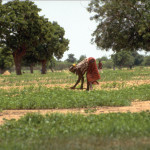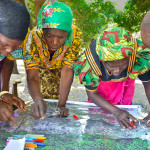Abstract: This paper investigates linkages between women’s empowerment in agriculture and the nutritional status of women and children using 2012 baseline data from the Feed the Future population-based survey in northern Ghana. Using a new survey-based index, the women’s Empowerment in Agriculture Index, we conduct individual-level analyses of nutrition-related indicators including exclusive breastfeeding, children’s dietary diversity >> Read more
Call for gender-sensitive social and behavior change for nutrition resources
Do you work in the fields of nutrition and food security? Have you successfully integrated gender-sensitive social and behavior change (SBC) activities into your projects/programs in order to improve nutrition outcomes for pregnant and lactating mothers and children under two during the 1,000 day window of opportunity? If so, we welcome your input! We are looking for resources >> Read more
Resources available from the second Gender-Nutrition Methods Workshop
Reposted from the A4NH Gender-Nutrition Idea Exchange blog On December 2-4, 2014, the CGIAR Research Program on Agriculture for Nutrition and Health (A4NH) held the second annual Gender and Nutrition Methods Workshop, hosted by Bioversity International in Rome. Following the successful first A4NH gender-nutrition workshop held in 2013 in Nairobi, this year convened over 40 researchers >> Read more
Using participatory mapping with a gender lens to understand how landscapes are used for nutrition
Many rural people derive their sustenance from sources embedded in their landscape – the cropland, pasture, trees, forests and rivers of their surroundings. The diversity of food in people's diets can be closely linked to how people manage the landscape. Yet there are often significant differences in how men and women interact with the landscape. >> Read more
News: Children of Empowered Women Grew Taller
Care and USAID highlights dramatic drop in child malnutrition and provides an inside look at a program called SHOUHARDO that combined nutritional support with women's empowerment initiatives to reduce child stunting, a key measure of malnutrition, by 28 percent in less than four years. That's twice the rate of the average U.S. government-funded food aid >> Read more
Funding: DFID
DfID’s Research and Evidence Division wishes to establish a new Research Programme Consortium (RPC) on Agriculture, Food and Nutrition Security in South Asia. This is part of a 6-year program in South Asia to maintain and further expand DFID’s commitment to increase agricultural productivity and promote sustainable management of natural resources for improved food security >> Read more
Publication: IFPRI 2020 Brief on ‘Gender: A key dimension linking agricultural programs to improved nutrition and health’
Improving the livelihoods and well-being of the rural poor is an important aim of agricultural development, promoted through agricultural intensification and commercialization strategies. But improved agricultural productivity does not necessarily translate into improved health and nutrition, either for producers or consumers. How can standard agricultural development strategies—promoting agricultural intensification, greater linkages to markets, and high-value >> Read more
Publication: Does increase in women’s income relative to men’s income increase food calorie intake in poor households? Evidence from Nigeria
Author: Adebayo B. Aromolaran Source: Agricultural Economics VL: 41 NO: 3-4 PG: 239-249 YR: 2010 DOI: 10.1111/j.1574-0862.2010.00442.x US: http://dx.doi.org/10.1111/j.1574-0862.2010.00442.x ABSTRACT This article addresses the important but not widely investigated question of how calorie consumption in African low-income households would respond to intrahousehold redistribution of income from men to women. Specifically, I use survey data on >> Read more
Publication: Patterns and trends of child and maternal nutrition inequalities in Nigeria
Author: Omilola, Babatunde (IFPRI) IFPRI Discussion Paper. Despite the fact that nonincome dimensions of well-being such as nutrition and health are now placed on the global development agenda, substantial gaps remain in our knowledge about patterns and trends in nutrition inequalities in many developing countries. The main objective of this paper is to document a >> Read more
News: Food or Cash? New IFPRI study assesses the effectiveness of transfer programs
What makes a more effective social safety net program: transfers of food, or cash? The question is hardly academic. Governments, international agencies, and non-governmental organizations must decide whether to provide the world’s poorest people with cash, food, or a mixture of the two. In recent years, many have begun favoring cash transfers over food aid. >> Read more


